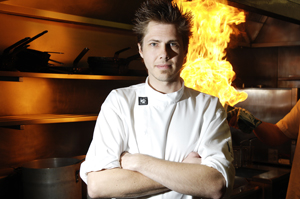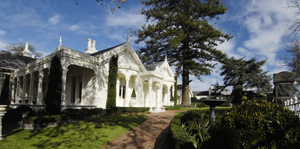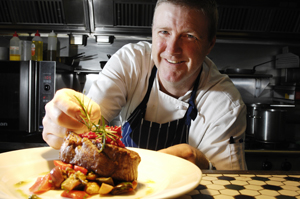Bottle of wine, fruit of the vine, what’s not to like about this nectar of the gods? Especially when Geelong and the coast host a stunning array of wine ties and wine experiences. Noel Murphy takes a sip …
Local chefs – Baveras Brasserie
DARIUS SARKIS’ interest in food flavours and technique began at a young age, with his first years of training taking place in Queenscliff at the famed Mietta’s. Now Darius is a well-known local chef who’s been cooking for 16 years.
Corio Villa
THERE HAVE been mixed fortunes for the few owners of this beautiful house, which is situated at Eastern Beach on Geelong’s waterfront. The present owners, Glenn and Rosslyn McAllister, kindly related the history to me as we wandered around their stunning, pre-fabricated, cast iron home, which has been in their family since 1945.
Community Gardens
VEGETABLE plots are in high demand at Geelong West Community Garden where the waiting list almost outweighs the number of members.
Nestled in the heart of inner-city Geelong West less than two blocks from iconic Pakington St, the garden is a natural haven featuring 34 members’ allotments.
The garden’s 20-year veteran member Rosemary Nugent says interest in community gardens has surged in the last decade thanks to a growing interest in sustainability.
“People are concerned about climate change. They want slow food. They want food that’s organic. It’s local, fresh and seasonal and it’s also cheaper.”
Geelong West’s garden has been operating since 1984, making it one of Victoria’s oldest. From the garden’s front entrance on Autumn St, a large leafy tree hides the organic refuge amid the concrete jungle of Geelong West.
Neat pathways weave between members’ plots, while fresh tomatoes, leafy greens, pumpkins and chillis stand out, asking to be picked.
“It’s very tranquil here even in the middle of a suburban area,” Rosemary says. “It’s very peaceful and we have good facilities.”
A covered communal kitchen area and a storage shed towards the back of the block sit next to a rear entrance and a car-park. The sheltered kitchen area has a gorgeous pizza oven, a barbeque, a stove and a wooden table to seat a large group.
Rosemary says members enjoy socialising and sharing food here the regular gatherings throughout the year. Members are welcome to visit the garden at any time to use the garden’s communal facilities and tend to their plots on an informal basis. “It is great to have a community garden where people can come and learn from each other, garden
together and help each other,” Rosemary says. “Sometimes we share seedlings or produce on an informal basis if we have extra.”
Quarterly meetings and working bees offer a chance for the group to formally organise and plan. Members are mostly Geelong West residents but also come from surrounding suburbs. “Early on there were more older people, but in recent years we’ve had many families with younger kids and people of all different nationalities join us,” Rosemary says.
The garden has strong roots in the surrounding community, welcoming school students and the general population for workshops teaching skills including gardening, mosaics and bread-making. Rosemary says children benefit from learning how vegetables grow.
“You don’t just go to the supermarket and buy them, or even worse, they don’t come in cans,” she laughs. “The kids are very proud of themselves when they can identify
veggies that are growing.”
TORQUAY’S Danawa Community Garden’s overall aims and values are similar to Geelong West’s but it operates in a very different manner.
Like Geelong West, Danawa is a tranquil space hidden behind lush trees, but instead of having individual allotments, its gardens are entirely communal. A beautiful mosaic sign marks the entry to the garden, which is wedged between tennis courts and an entry road on Torquay’s Spring Creek Reserve.
Fruit trees, an open grass space and compost plots share the area with luscious mandala, or circular, garden beds hosting deliciouslooking vegetables.
Like Geelong West, Danawa has an undercover meeting area and a pizza oven. A greenroom hosts an extensive list of tiny plant crops preparing to be planted or picked. Vegetables growing include sweet potato, spinach, beetroot, carrots, snowpeas and a range of herbs and Chinese vegetables.
Member John Harrison says when the garden started about nine years ago it had some individual plots but the group has since evolved to prefer sharing the workload and the bounty. “We found people went away on holidays and plots were left so we decided we’d just have communal plots and everyone can work on them,” John says.
Member Jeremy Rugless says the group dynamic is easy-going and decisions are made without conflict. Regular work at least twice a week is essential to maintain the garden, with a core group of about twelve members visiting the garden regularly, and a further 25 members attending less often. The garden hosts twice-monthly food swaps and regular “pick and plant” days.
Nina Travis says members have a range of reasons for joining Danawa. “It’s a matter of getting out, seeing something new, meeting new people and having more space.” Torquay’s broader community gets involved with Danawa’s annual Winter Solstice and Harvest Festival, with familyfriendly activities including dance and music performances.
Jeremy says regular members nearly always take food home from the garden’s pick and plant days. “For half the year, regular members are having three to four serves a week of veggies from the garden,” he says.
Where is your nearest community garden?
ANGLESEA COMMUNITY GARDEN
5 McMillan Street, Anglesea.
For further information, please phone 5263 2116
AIREY’S INLET COMMUNITY GARDEN
2 Fraser Drive, Airey’s Inlet.
For further information, please phone Terrence on 0438 533 346 or email thof4@bigpond.com
BARWON HEADS COMMUNITY ARTS GARDEN
Barwon Heads Reserve,
38 Geelong Road,
Barwon Heads.
For further information please visit http://www.bhartsgarden.com/
DANAWA COMMUNITY GARDEN, TORQUAY
Spring Creek Reserve,
Torquay.
For further information, please email perryagmills@gmail.com
GEELONG WEST COMMUNITY GARDEN
129 Autumn Street,
Geelong West.
For further information please visit http://www.geelongwestcommunitygarden.org/
LORNE DAISY AND OLIVE COMMUNITY GARDEN
Figtree Community House,
16 Mount Joy Parade, Lorne.
For further information, please phone 5289 2972
POINT LONSDALE COMMUNITY GARDEN
2 Nelson Road, Pt Lonsdale.
For further information, please phone Sarah on 5258 0814 or email sarah.wynn@bch.org.au
WINCHELSEA COMMUNITY GARDEN
51 Hesse Street, Winchelsea.
For further information, please phone Virginia on 5267 2866
Artist in Residence
Something just felt right for Jenna Ramondo when she picked up her first SLR camera.
Experimenting with photography in her down time from studying design and multimedia, Jenna found the more she learnt, the more her passion grew.
A self-confessed arts fan, Jenna was the perfect choice for the curator position of this year’s Courthouse Arts project, Kaleidoscope Gallery.
History Repeated – Couta Boats of Queenscliff
NO SINGLE boat builder is credited with designing Queenscliff’s iconic couta boat. It simply evolved between the 1890s and the 1920s in the hands of Queenscliff boat builders such as Andrew Hansen, Mitch Lacco and Peter Locke. These craftsmen experimented and modified the design to suit their customers – the professional fishermen.
Hansen preferred the clinker style of hull construction whereas Lacco used the carvel method, giving the hull a smooth finish.
Peter Locke liked to use Western Australian karri or jarrah for the keel in his boats. The keel, tapered at both ends, was made from a piece of timber 100mm thick by 300mm wide.
Queenscliff’s John Beazley, who spent 50 years as a shipwright with Port Phillip Sea Pilots, tells of his grandfather, fisherman Walter Todd, who commissioned Hansen in 1899 to build him a 26-footer.
“My grandfather called the boat Merri-wee after the horse that won that year’s Melbourne Cup.
“The boat cost 45 pounds ($90) and it is still around to this day,” John recalls.
During the 19th Century, fishermen were net fishing off the beach using five-metre flat-bottomed boats.
“As the supply of fish decreased in the bay they looked outside The Rip to the huge shoals of southern barracouta. These great schools could be nearly 30 kilometres long,” John says. “Fish in these couta shoals were about 80cm long and weighed two kilograms. At the time, there was a huge demand for couta from the Victorian public.
“The 26-footer was a good seaworthy working boat and perfect for couta fishing. Two men could work and sail it at the same time and if they had to get the oars out they could row her easily.”
John says his grandfather would get up at 3am in the 1920s, walk down the pier and join other fishermen in the waiting shed. Here they would yarn before preparing their boats. They’d leave Queenscliff still in darkness about 4.30am, sail out through The Rip and keep going out till daylight before they’d start fishing.
During the heyday of the fishing industry in the 1920s as many as 65 couta boats worked out of Queenscliff.
“Once out in Bass Strait, they had to find the couta” John recounts. The fishermen would watch the gannets. If they were diving on baitfish that’s where the couta would be.
“Often the fishermen would have to sail as far down as Split Point (Airey’s Inlet) about 14 nautical miles in search of couta.
“The fishermen would sail up and down trolling over the couta. They’d flick the fish back under their left arm, grab the head and pull the hook out.
“Couta have a large mouth and they’ve got a nasty set of teeth. I’m amazed no one lost fingers.”
John says the fishermen modified their oilskin coats with extra-thick patches sewn under their left armpits. The patches were almost three quarters of an inch thick and heavily sewn. “The couta would grab at the coat and tear at it with their teeth.”
Queenscliff fishermen used cattle hide as a lure. “They’d buy up a big lot of Hereford hides from the slaughter yards in Geelong and share it around,” tells John.
“It was the white piece from around the Hereford’s head or hooves they preferred.” The hide was cut into five-inch strips with the hair up on the hook so the couta could see the white flash as the lure danced through the water.
“It would keep soft and they could get three or four days out of a piece of hide before it was torn to pieces by the couta.” Fishermen would berley the shoal of couta with handfuls of whitebait thrown over the side.
“They’d go like hell to fill their 20 box limit, always with one eye on their watches so they could get back to The Rip for the flood tide,” Beazley says.
“The only way back through The Rip was on a flood tide, never the ebb.
“The ebb pushed up a wall of broken water with a seven-knot current pushing out.
“Sometimes the men would knock off fishing earlier just to catch the tide.
“When they got close to The Rip and it looked like it was going to be a rough entry they’d strip off their heavy sea boots and oil skins down to their underwear.
“Queenscliff fisherman George Jurgens was one who could read the sea. He would say if the boat ever shipped a big sea over the bow and she went over, he’d go down like a stone in his heavy boots and oil skins on.”
Jurgens kept an empty 20-gallon drum in the boat in case he went over to help keep him afloat. There were lucky escapes among the fleet but no fisherman was ever lost when the full fleet re-entered the bay.
“They carried no lifejackets, flares, no safety equipment at all,” John marvels.
“No one ever stayed out. If you got into trouble when all the boats were out there was always someone nearby to help.
John says it was a magnificent sight to see 60 boats under sail heading back to The Rip.
“As a ten-year-old I used to watch them from the back beach and then race down to the pier and help my grandfather pack the fish into boxes. He would always give me a couta to take home.”
Queenscliff Maritime Museum’s Les Irving-Dusting remembers his grandfather, Hedley Dusting, as a couta fisherman who also went after crayfish.
“They’d haul in the craypots with their bare hands,” Les recalls.
“The pots might contain 20 to 30 big crays.
“Sometimes they would be several miles off the heads when the wind would drop and they’d have to row home.
“My grandfather ended up with ‘claw hands’ in his old age after years of suffering frostbite in the bitterly cold conditions.”
The Queenscliff couta boat fleet gradually diminished as the demand for couta declined. By the 1960s only a handful of couta boats remained at Queenscliff.
In 1971 wooden boat enthusiasts began seeking out the old couta boats to buy and restore them to sailing condition. Some boats were still being used, others were propped up in back yards deteriorating. Hulls were restored, new sails sewn and the boats re-rigged.
Today the couta boat register lists 184 boats. Many are restored original workboats used by early fishermen. Queenscliff celebrates the couta boat each year in March with a weekend of maritime activities including the traditional blessing of the fleet service followed by a couta boat regatta on Port Phillip Bay.
Local chefs – Edge Geelong
Stewart Atchison is head chef at Edge Geelong. Stewart came from Camperdown as a teenager to take up an apprenticeship at Fishermans Pier in Geelong on the Waterfront. 25 years later his career has brought him back to the Waterfront as head chef at Edge Geelong. This colourful dish is one of the most popular dishes on Edges new winter Menu.
In Conversation with Xavier Rudd
Jan Juc’s multi-instrumental folk-roots icon, Xavier Rudd, chats with Michelle Herbison about his connection to the Geelong and coast region and his new album, Spirit Bird.
















